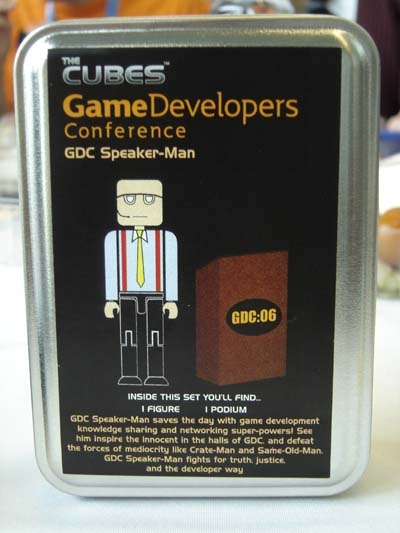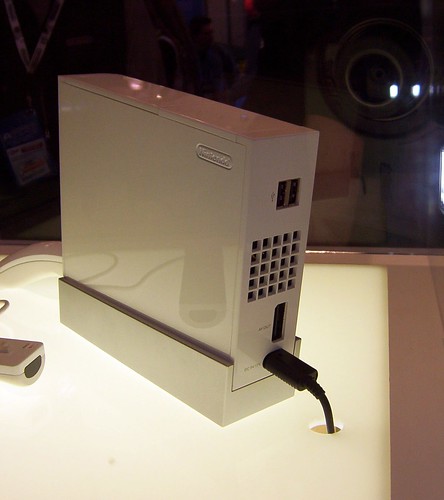Putaiiiin et dire qu’il ya un kit de dev de Revolution à 10 mn à pieds de chez moi… Rien à voir (ou presque) ça me fait penser que j’aimerais bien faire une DS Lan en extérieur (Lâm, t’organises ? :p). C’est vraiment cool de jouer dehors.
Le buzz internet. L’industrie du jeu en profite plus qu’aucune autre. Les blogs, forums sont disséqués en ces temps où les éditeurs ne savent plus quoi faire, voyant leurs ventes stagner voir chuter.
Ce Red Steel d’Ubi et sa mise à nue au fur et à mesure que les avis positifs s’accumulent, en est la preuve et d’ailleurs je participe à son buzz là-tout de suite-maintenant.
C’est encore bien trop tôt pour émettre un avis, le concept est pas incroyable pour un sous et le charisme des premières images n’existe pas, soyons francs. Les gens se prennent le choux sur des détails à la con, preuve que les hardcore gamers sont immatures ou manquent totalement de capacités d’abstraction ("I’m shocked Nintendo didn’t learn the lesson from MortalKombat" Killer7 someone ?.. boulets) Et c’est pareil partout: le joueur veut du gore, que ça gicle avec filtrage aniso… Ca me déçois que cet esprit très "j’ai 16 ans et trois poils" persiste et reste majoritaire. Il faut que ça change et c’est lent bordel.
D’ailleurs il faut vraiment que le monde des joueurs soit immature pour que ça, puisse exister. Mon dieu.
Dernier volet de l’analyse de Warren. Les développeurs savent depuis des années que le retail à l’ancienne, l’extrême pouvoir de censure et autres joyeusetés de la grande distribution (comme Wal Mart) font qu’aujourd’hui nous sommes pieds et mains liés, nous les créateurs.
Aujourd’hui on annonce HL² Episode 1 en download sur Steam. Mais c’est tout HL² qui aurait dû être distribué de cette façon. Ca aurait permis d’améliorer le level design, l’histoire au fur et à mesure du feedback. Fahrenheit pareil. Et tout un tas de jeux, peut être même tous en fait. Bone est distribué online mais le prix (et la cible) n’est pas le bon à mon avis…
Comme dit Warren, "Heck, even EA execs are beginning to talk about the importance of going direct to consumers, and they own traditional retail distribution!" C’est dire comme on est lent. Ou ces immenses boites sont très réactives, mais je le pense moins…
Une autre petite citation qui me parle:
"We have to allow more people with more varied interests to participate in game creation."
Mec, je ne sais pas d’où viens ce refus de faire entrer des personnes autres que codeurs ou graphistes dans le développement de jeux, mais c’est extrêmement difficile alors que les jeux du Soleil Levant nous montrent la voie à suivre mais nous, on regarde le doigt encore et toujours. Tiens, un exemple parmis tant d’autres (voir les coms).
En y mettant toute mon énergie, toute mes capacités, en poussant les portes depuis des années j’y arrive à peine. Et je suis loin d’en croûter, même s’il y eu une période où c’était le cas. Et on est en 2006. Je te jure Warren, quand je rêvais de faire ce métier vers je sais pas, 1991-1992, en aucun cas je pensais que le jeu serait toujours dans la même position sociale de "niche à gamins qui aiment la violence", je pensais que ça serait un truc fabuleusement enrichissant qui rendraient les gens super cool. En fait je pensais que tout le monde de ma génération voudrait bosser sur des jeux car c’était, c’est notre culture première. Je suis le seul et vu comme je galère, ça donne pas envie je sais.
C’est comme ça que pas mal voulaient, au mieux, vendre des jeux dans une boutique. J’ai rien contre mais purée… Pour des gens qui comme moi parlaient que de ça pendant des années, pendant des heures et des heures de récrés (jeux, meufs, baskets, basta) je m’attendais à un ras de marée de jeunes voulant travailler dans une industrie de pointe, franchement sympa. Un ras de marée qui allait changer la perception du jeu. La pression des vieux parents, largement non joueurs -en tout cas en Europe-, le manque de visibilité sur les métiers/salaires ont sans doute eu un rôle à jouer. Ah et la tonne de travail aussi, vu l’état d’esprit des miens…*tousse*
Non je suis pas aigri, je râle mais j’ai les crocs (et là au sens propre comme au figuré), plus que jamais. Je retourne sur mon Kirby sourire et pousser des petits cris, tiens.









